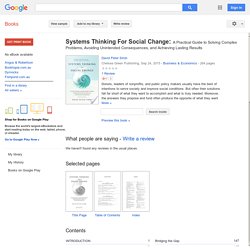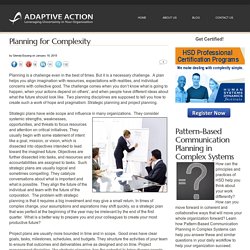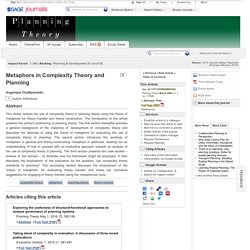

8287. Planning with Complexity: An Introduction to Collaborative Rationality for ... - Judith E. Innes, David E. Booher. W3 Nelson TheDesignWay Chapt 1. Systems Thinking For Social Change: A Practical Guide to Solving Complex ... - David Peter Stroh. Donors, leaders of nonprofits, and public policy makers usually have the best of intentions to serve society and improve social conditions.

But often their solutions fall far short of what they want to accomplish and what is truly needed. Moreover, the answers they propose and fund often produce the opposite of what they want over time. We end up with temporary shelters that increase homelessness, drug busts that increase drug-related crime, or food aid that increases starvation. How do these unintended consequences come about and how can we avoid them? By applying conventional thinking to complex social problems, we often perpetuate the very problems we try so hard to solve, but it is possible to think differently, and get different results. Systems Thinking for Social Change enables readers to contribute more effectively to society by helping them understand what systems thinking is and why it is so important in their work. Ajbms201211i11111. How to strengthen innovation – good practice vs. emergent practice.
The last week of June I had the privilege of attending a three-day training event with Dave Snowden, founder of Cognitive Edge and “mental father” of the Cynefin framework.

For me this was a great experience and although I had read a lot of stuff around complexity (also by Dave), there were still many new insights I got. Some things were new, others just became clearer. One thing that I knew but that was becoming more pronounced during the training is the differentiation between best/good practice and emergent practice. In the ordered domains on the right side of the Cynefin framework, cause-and-effect relationships are clear, if also in the case of the complicated domain not necessarily obvious.
Cause-and-effect relationships don’t shift and we can always expect the same result when we do the same thing. What are the consequences for our work in economic development? Wicked. The Design Way: metaphysics. Evil, splendor, and the guarantors of destiny & design This blog post attempts to summarize Section IV: Metaphysics of Nelson and Stolterman’s “The design way” (TDW: 2012, 2003), see also the six previous posts.

TDW merges several intellectual traditions, including Churchman’s systems approach, which also inspired our own book “Wicked Solutions.” It is not surprising that there are interesting parallels between the books, some of which we are happy to point out (to ourselves in the first place) at the end of this summary. Evil of design Several metaphysical issues arise from a design approach to life.
The Heretic's Guide to Best Practices: The <i>Reality</i> of Managing Complex ... - Paul Culmsee; Kailash Awati. When it comes to solving complex problems, we often perform elaborate rituals in the guise of best practices that promise a world of order, certainty, and control.

But reality paints a far different picture, which practitioners are often reluctant to discuss. A witty yet rigorous journey through the seedy underbelly of organisational problem solving, The Heretic’s Guide to Best Practices pinpoints the reasons why best practices don’t work as advertised and what can be done about it. Wicked. Wicked Solutions : A Systems Approach to Complex Problems - Bob Williams, Sjon van 't Hof. Systems thinking and evaluation. Impact Factor:1.906 | Ranking:Social Sciences, Interdisciplinary 11 out of 95 Source:2014 Journal Citation Reports® (Thomson Reuters, 2015) Evaluationevi.sagepub.com doi: 10.1177/1356389011421935 Evaluation October 2011 vol. 17 no. 4 395-403 The first page of the PDF of this article appears below.

Click image below to view at full size. Planning for Complexity. Planning is a challenge even in the best of times.

But it is a necessary challenge. A plan helps you align imagination with resources, expectations with realities, and individual concerns with collective good. The challenge comes when you don’t know what is going to happen, when your actions depend on others’, and when people have different ideas about what the future should look like. Untitled. In this article, we argue that Niklas Luhmann has a lot to offer present-day planning theory.

Metaphors in Complexity Theory and Planning. This article reviews the use of complexity theory in planning theory using the theory of metaphors for theory transfer and theory construction.

The introduction to the article presents the author's positioning of planning theory. TISandersEssay. Managerialism in Complex Systems: Experiences of Strategic Planning in Non-Profit Hospitals. <div class="c-box-warning full-width-element" style="text-align: center; "><div style="margin: auto; padding:10px;" class="container"><b>For full functionality of ResearchGate it is necessary to enable JavaScript.

Here are the <a href=" rel="nofollow" target="_blank"> instructions how to enable JavaScript in your web browser</a>. </b></div></div> Abstract The aim of this study was to analyse strategic planning practices in complex systems by investigating the experiences of Brazilian non-profit hospitals.
Growing pressures have been imposed upon hospitals to improve the quality of their services, to increase access to them by reducing costs and to improve their reliability. CitationsCitations0ReferencesReferences3 Seyed jamaledin Dryabari Habib Nasirifar Data provided are for informational purposes only. An error occurred while rendering template. A complex systems approach to planning, optimization and decision making for energy networks. <div class="c-box-warning full-width-element" style="text-align: center; "><div style="margin: auto; padding:10px;" class="container"><b>For full functionality of ResearchGate it is necessary to enable JavaScript.

Here are the <a href=" rel="nofollow" target="_blank"> instructions how to enable JavaScript in your web browser</a>. </b></div></div> Human Relations. Authors Chris Hendry The management of change has become characterized by an atheoretical pragmatism, overfocused on the political aspects of the change process. Emerging interest in the learning organization provides an occasion to remedy this, by developing a theory of change which is more congruent with the requirement to build learning capacity within organizations. The result should be to place learning theory more centrally within the theory of planned organizational change. "Emergent Learning" Is an Oxymoron -e-Literate. In the introduction to Steven Johnson’s oft-referenced but seldom understood book Emergence: The Connected Lives of Ants, Brains, Cities, and Software, he describes emergent systems as follows: In the simplest terms, they solve problems by drawing on masses of relatively stupid elements, rather than a single, intelligent “executive branch.”
They are bottom-up systems, not top-down. They get their smarts from below. In a more technical language, they are complex adaptive systems that display emergent behavior. In these systems, agents residing on one scale start producing behavior that lies one scale above them…. The key idea here is that the individual agents do not generally understand and consciously orchestrate the observed emergent behavior. Emergent learning and learning ecologies in Web 2.0. Special Issue - Connectivism: Design and Delivery of Social Networked Learning Roy Williams University of Portsmouth, UK Regina Karousou Independent Educational Researcher, UK Jenny Mackness Independent Education Consultant, UK Abstract This paper describes emergent learning and situates it within learning networks and systems and the broader learning ecology of Web 2.0. The paper argues that although social networking media increase the potential range and scope for emergent learning exponentially, considerable effort is required to ensure an effective balance between openness and constraint.
Emergent Learning is using your own work to become a learning organization. In complex and changing situations, there are no right answers…, at least not for very long. Our answers are really hypotheses that represent our current best thinking about what it will take to get the results we intend. Emergent Learning enables organizations or networks to adapt their strategies and action plans, in-course, to achieve the results they want. Through Emergent Learning, know-how emerges in the course of doing work (in contrast to learning that happens away from work in a classroom setting). Emergent Learning is pragmatic, so it means overcoming challenges, especially those that have no simple solutions, but require discipline, ongoing attention, learning through experience, and adaptation.
Learning emerges from the work itself, because learning is built directly into the flow of work. Managing emergent practice. What would happen if you called for closing your training department in favor of a new function? Imagine telling senior management that you were shuttering the classrooms in favor of peer-to-peer learning. You’re redeploying training staff as mentors, coaches, and facilitators who work on improving core business processes, strengthening relationships with customers, and cutting costs. You’re going to shift the focus to creativity, innovation, and helping people perform better, faster, cheaper. You might want to give it a try. Perhaps the time has come. This is how Jay Cross and I finished our article on The Future of the Training Department.
Emergent Practice Planning - Frances Ricks, Jennifer Charlesworth. Knowledge management. Process of creating, sharing, using and managing the knowledge and information of an organization Knowledge management (KM) is the process of creating, sharing, using and managing the knowledge and information of an organization.[1] It refers to a multidisciplinary approach to achieve organisational objectives by making the best use of knowledge.[2] Emergent Practice Planning. Emergent Strategy - Knowledge Center. Moving toward emergent strategy: slowly, if at all. The conventional thinking about strategy and its role in the conduct of business has slowly started to change as a result of the shift to a new economy, the postnormal.
But it hasn’t gone very far, except in a small segment of businesses, because the control of strategy is seen as the means to effectively manage the business in a top-down fashion, while theoretically giving more autonomy in the execution of strategy to individuals. And in this way, management seeks to continue its dominance over strategy, as a centralized set of activities used to control the business: its direction, goals, and increasingly embedded directly into the values at the core of the organization’s culture. Intended, Emergent, and Realized Strategies. 1.2 Intended, Emergent, and Realized Strategies Learning Objectives. Emergent Strategy. September 11, 2012 There is nothing wrong with strategic planning – except when we believe that strategy unfolds as planned. A good strategic planning process is one that crystalizes our intention. Forbes Welcome. The Emergent Way: How to achieve meaningful growth in an era of flat growth.
The Emergent Way: How to achieve meaningful growth in an era of flat growth.